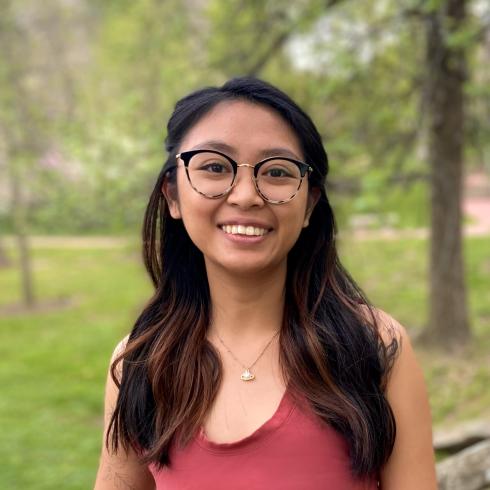As a Filipina living in Indiana, it’s not often that I hear my parents’ native language. However, as soon as I arrived in Milan, I was struck by how often I began hearing it. In the metro, at tram stops, in coffee shops… I could go on.
Then, I began my internship, and I was ecstatic to find that my office was located in Milan’s Chinatown. It was the first time I had ever really felt like I was surrounded by a lot more people who looked like me, and the first time that I felt like I was seen as a person beyond just my race. In the States, where I live, as usually the only Asian or person of color in any given room, my race is often regarded as something novel and amusing for others. It gets remarked on often, and usually not in a way that indicates genuine curiosity - for example, while waiting tables in high school, I often had customers who were older men that liked to play a guessing game of where I was from, often ending the conversation by telling me that I reminded them of their ex-wives.
However, in Milan, the prevalence of other Asians in the city has led my race to not be a defining characteristic when I meet with or talk to people. When people begin conversation, there is usually not even an assumption that I am a foreigner, and people don’t try and greet me with a “Konichiwa” or “Ni hao” - they simply say “Ciao,” which is a very welcome change from how people treat me in the States, even as a person who grew up and was raised there speaking English as my first language. Nevertheless, this does not mean that racism is nonexistent.
While taking my internship class, we discussed issues of racism, and while of course, my experiences as someone Asian will differ from those of other people with other racial and ethnic backgrounds, I thought I would provide a little bit of history on how Asians grew to represent such a large percentage of the Milanese population, and how racism now continues to affect Asians specifically in Milan/Italy.
As early as the 1920s, Chinese workers began settling in Milan, and just a few decades later in 1979, Milan and Shanghai became sister cities; the first time that an Italian city ever made such a connection. With Milan already having solidified its position as a world capital for fashion, and Shanghai supporting high levels of silk production, a lot of trade occurred between the cities. As this economic and cultural relationship developed, immigration between the cities became frequent, leading to the development of Milan’s Chinatown.
While in this part of the city, I loved how easy it was to find Asian foods and grocery stores and to be exposed to Asian fashion. Some of the bigger grocery stores I frequented included Tang Food Market and Chineat, and I especially enjoyed shopping at Tang Food Market because of the section specifically dedicated to Filipino foods. Nevertheless, there were a few things that were unexpected about this part of the city. For those familiar with American Chinatowns, most will see this as looking very different due to the European architecture that still permeates this part of the city. I also had a few friends remark that even the Asian grocery stores here seemed cleaner than most Asian grocery stores you would find in the States. Finally, I also was pretty surprised by some of the high pricing in clothing stores in this part of the city. Maybe it is a stereotype, but in my experience at least, many Asian Americans, and specifically Chinese Americans tend to be very frugal, so I was surprised to see plenty of skirts and dresses in stores all across Chinatown priced at 70-100+ euros, with hardly any clothing items being priced below 30 euros, with the exception of a few more affordable stores (Gianni Moda and AZ Fashion), which admittedly, I felt sold more Western-style clothing than traditional/ethnic styles.

Circling back to my earlier point about hearing Tagalog spoken in Milan, many Filipinos also were able to easily integrate into Italian/Milanese culture throughout the years due to similarities such as shared religion (Roman Catholicism). Currently, statistics state that Filipinos now make up one of the (if not the) largest immigrant population for the city of Milan (10%), and as a country, Italy has been known to be home to the most Filipino emigrants across all of Europe. While most of them have come to work as housekeepers or mayordomas, some have also appealed to the Italian’s love of good food by opening highly successful restaurants around the city, such as Mabuhay.
Despite this long history of shared space though, racism against Asians has persisted in Milan. Unlike in the US, where race is often acknowledged, in Italy, there is more of a hesitancy or reluctance to admit that people even “see” race at all. Like the US though, COVID-19 was an instigator for many acts of racism and hate crimes against members of the Asian community, and though the frequency of which such events have occurred has certainly decreased in the years following its peak, some people still have maintained negative perceptions of Asians that have led to continued microaggressions or more explicit racism in even just the past year, such as an incident involving a viral TikTok of Italian university students mocking Asians on a train in 2023. When people reached out to their universities (Università Cattolica del Sacro Cuore, IULM University and The University of Milano-Bicocca), all three affirmed that they did not support racism, yet only one mentioned consequences for the student, saying that they would “educate” the student in question.
Overall, my observations are that for the most part, Milan feels like a safe place to exist as an Asian woman. However, like in all places, there will be tension when people are faced with people who appear to be different from themselves. I think that part of what perhaps contributed to my feelings of safety and comfort within the city could be due to the fact that I spent most of my time in a part of the city with a high concentration of Asians (Chinatown), and I understand that in other parts of the city, I might not have always felt the same way.
However, I still had fun moments of connection with other Filipinos and Asians in the city outside of Chinatown, as well as with other Italians, and I am very happy and satisfied with my study abroad experience, and I can report that I did not feel like I noticed or experienced much racism or even microaggressions against myself while in the city.
For more detailed information, on any of the topics I discussed, I’m attaching links to the following articles that may be of interest:
Why 200,000 Filipinos happily live in Italy? | Philstar.com
Chinatown, Milano an interesting story | lorrie graham (lorriegrahamblog.com)

Ana Lim
Hi, I'm Ana! I'm a Filipino-Chinese senior at IU studying Social Work with an International Studies minor. Things that make my heart smile include laughing with loved ones, playing with pets, & enjoying long naps. Hope you enjoy Italy with me!








